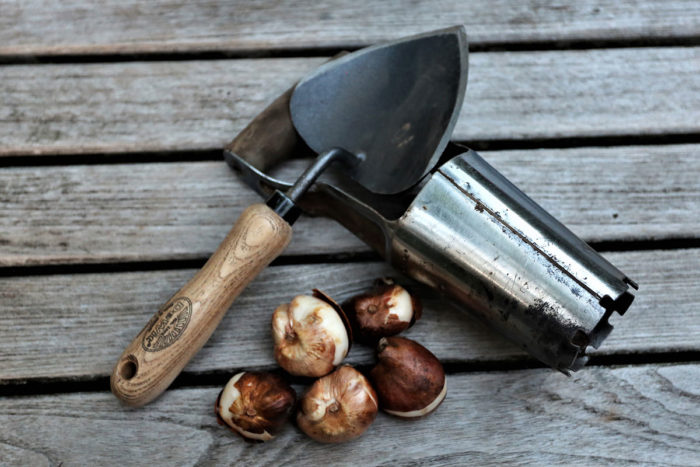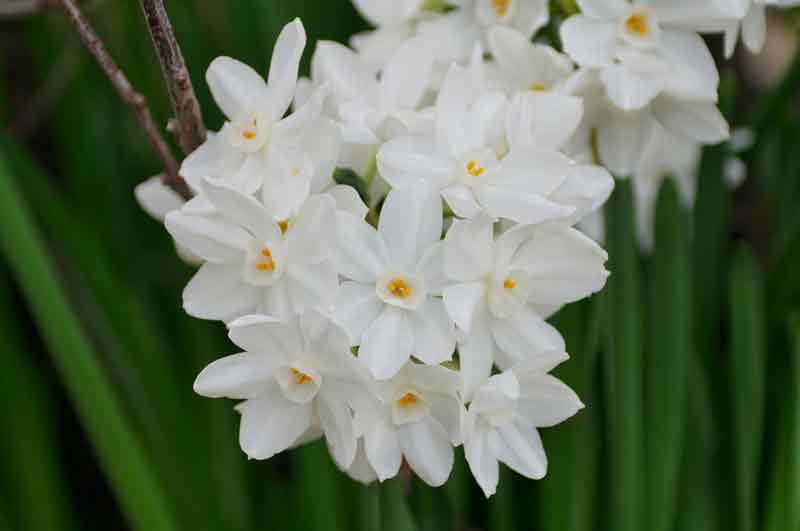
In November the days are even shorter, the cold has set in, and with any luck, rains are a regular occurrence. Most gardeners are less inclined to spend time outdoors, but as long as weeds are still growing and fallen leaves continue to provide overwintering hiding spaces for insects, slugs, and snails, there are still chores to be done.
In the Ornamental Garden

Plant camellias. While they’re in full bloom and available in your local nursery, it’s the perfect time to purchase and plant camellias (Camellia spp. and cvs., Zones 6–10), particularly the hardier sasanquas (C. sasanqua, Zones 7–9). Profusions of showy, colorful, sometimes fragrant blooms will brighten up your fall and winter garden for years to come, and the glossy green, evergreen foliage will provide an elegant year-round presence in your shade or woodland areas.
Clean up beneath your rose bushes to help prevent future fungal problems. Monitor for disease and pest issues as well.

Add spring interest. Keep planting spring-flowering bulbs, native plants, and spring-flowering bedding plants for a spectacular show next spring.
Divide perennials. There’s still time to divide overgrown perennials such as daylilies (Hemerocallis spp. and cvs., Zones 3–10), Shasta daisies (Leucanthemum × superbum cvs., Zones 5–9), and agapanthus (Agapanthus spp. and cvs., Zones 6–11).

Dig up and store dahlias. In areas where the ground freezes, dahlia tubers (Dahlia spp. and cvs., Zones 7–11) should be dug up, cleaned, and stored in a clean, dry location in vermiculite or sand. In milder areas, allow your dahlias to go dormant and leave them to overwinter in the ground.
In the Edible Garden

Protect tender fruit crops from the cold. Although the coldest months in Northern California are usually January and February, gardeners should be prepared for frost in November and have frost cloth at the ready in case temperatures threaten to dip below freezing. While your deciduous fruit trees are unbothered by frost, citrus trees and kiwi vines need protection. On chilly nights, simply suspend frost cloth over the tender plants using hoops or a frame made from bamboo or PVC pipes, removing the cloth the following morning.
Clean up debris under fruit trees. Be particularly diligent about cleaning up leaves and debris from under fruit trees to prevent fungal spores carrying over to next year. After cleanup, mulch well with a layer of well-composted manure or plain compost to add nutrients to the soil.

Protect vegetables from frost. Cold weather slows down growth in the vegetable garden, but it also means fewer pests to deal with and easier maintenance in general, including less watering. Garlic, onions, brassicas, and leafy greens such as kale, Swiss chard, and cold-hardy lettuces can all still be planted in November. One more direct sowing of peas, carrots, beets, and radishes can also be squeezed in before the year ends, but be sure to protect crops from foraging birds with bird netting, if necessary. For more on protecting crops from frost, read on here. Finally, plant a cover crop such as fava beans in any empty vegetable beds.
Prevent peach leaf curl. Begin a fungicidal spray program for your dormant peaches and nectarines.
In the Indoor Garden

Force paperwhites. On chillier days, one very pleasant November indoor gardening “chore” is forcing paperwhites (Narcissus spp. and cvs., Zones 8–11) so that they will bloom in time for the holidays. In a cool, dark location, place the bulbs in your container of choice at least six weeks before the desired bloom date, watering carefully so that the water comes to just below the bottom of the bulbs. In approximately three weeks, as soon as the roots are visible, move the container to a cool, sunny spot. Within three more weeks, you’ll be rewarded with a beautiful display of delightfully fragrant blooms.
—Fionuala Campion is the owner and manager of Cottage Gardens of Petaluma in Petaluma, California.


















Comments
Log in or create an account to post a comment.
Sign up Log in